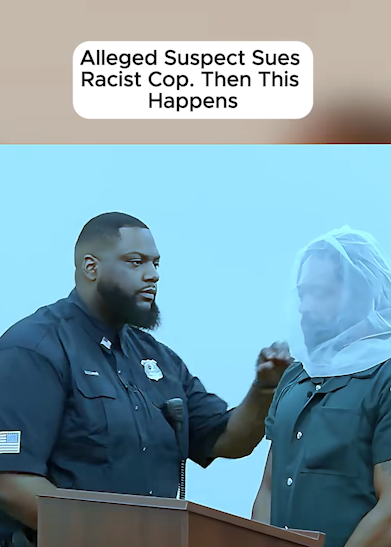
A short but explosive courtroom clip has been sweeping through Facebook and TikTok feeds under the headline: “Alleged Suspect Sues Racist Cop. Then This Happens.” In the 15-second video, a uniformed officer stands at a lectern while a defendant — dressed in a dark vest and wearing a sheer white mesh hood — appears before him. The imagery alone has been enough to ignite thousands of comments and shares, but what’s really going on behind the clip remains murky.
The video opens with the defendant, his face obscured, standing beside the officer as if waiting for a ruling. A caption explains that the hooded man had filed a lawsuit accusing the officer of racism. Without context, viewers are left to assume the case is real and unfolding in a genuine courtroom. In fact, there is no verified news story matching this incident and no public court records showing a suspect suing a police officer under these circumstances.
That hasn’t stopped the clip from going viral. The juxtaposition — a Black officer and a hooded man claiming racial bias — touches a nerve in online discussions about policing, discrimination and accountability. Some commenters have praised the officer’s calm demeanor, suggesting that the “twist” promised by the caption is that the officer turns out to be a model of professionalism rather than the villain of the story. Others suspect the footage is from a dramatized or scripted video designed to provoke outrage or sympathy, rather than actual courtroom footage.
Part of the confusion stems from the way social media platforms reward eye-catching titles and ambiguous storytelling. Headlines like “Then This Happens” encourage viewers to watch and comment before verifying facts. It’s a tactic long used by clickbait publishers but now common in short-form video content. By the time someone points out that a clip may be staged, it may have already been shared hundreds of thousands of times.
The hood itself has also become a flashpoint. Some viewers assume it symbolizes punishment or humiliation; others speculate it’s a prop meant to anonymize an actor. Without clear sourcing, nobody can confirm whether the hood has any real-world procedural use or if it was chosen purely for dramatic effect.
Regardless of the video’s authenticity, the clip underscores how quickly narratives can form online. A single caption can frame a complex situation — or a piece of fiction — as proof of bias, misconduct or injustice. In this case, a story about a “racist cop” being sued flips expectations by showing a Black officer and a hooded defendant, creating a moment designed to shock and share.
Until a credible source identifies the people involved or the origin of the footage, the real story behind “Alleged Suspect Sues Racist Cop. Then This Happens” remains unknown. What is known is how effectively such videos harness controversy to travel far beyond their original uploaders, shaping public perception with a few charged words and seconds of video.




